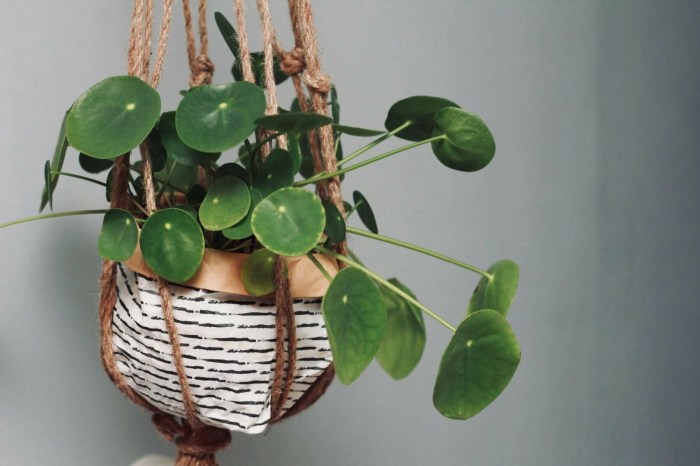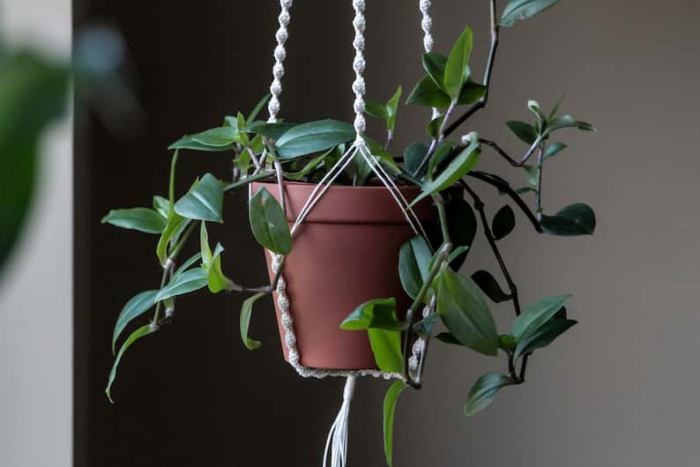As low light hanging houseplants take center stage in modern home décor, they offer a unique blend of beauty and functionality, transforming living spaces into tranquil oases. With their ability to thrive in dimly lit environments, these botanical wonders bring a touch of nature indoors, adding vertical interest, purifying the air, and creating a sense of serenity.
From trailing pothos to cascading ferns, the diverse range of low light hanging houseplants caters to every taste and style. Their varied growth habits, foliage characteristics, and special care requirements make them fascinating subjects for plant enthusiasts and casual decorators alike.
Types of Low Light Hanging Houseplants
Hanging houseplants can add a touch of greenery and life to any room, even those with low light levels. Many species of hanging houseplants can thrive in low light conditions, making them ideal for dimly lit spaces.
Here are some popular types of low light hanging houseplants:
Pothos
- Pothos ( Epipremnum aureum) is a fast-growing vine with heart-shaped leaves that come in a variety of colors, including green, yellow, and white.
- It prefers low light conditions and can tolerate infrequent watering.
Philodendron
- Philodendron is another popular genus of hanging houseplants, with many species to choose from.
- They typically have large, glossy leaves that can be green, variegated, or even red.
- Philodendrons prefer low to medium light and should be watered regularly.
Spider Plant
- Spider plants ( Chlorophytum comosum) are known for their long, trailing leaves that produce plantlets at the ends.
- They prefer low to medium light and can tolerate infrequent watering.
- Spider plants are also known for their air-purifying abilities.
String of Pearls
- String of pearls ( Senecio rowleyanus) is a unique hanging succulent with long, trailing stems covered in small, pearl-like leaves.
- It prefers bright indirect light but can tolerate low light conditions.
- String of pearls should be watered sparingly, allowing the soil to dry out completely between waterings.
Hoya, Low light hanging houseplants
- Hoyas are a genus of flowering hanging houseplants with waxy leaves and clusters of fragrant flowers.
- They prefer low to medium light and should be watered when the soil is dry to the touch.
Peperomia
- Peperomias are a large genus of hanging houseplants with a wide variety of leaf shapes and colors.
- They prefer low to medium light and should be watered when the soil is dry to the touch.
Benefits of Low Light Hanging Houseplants

Incorporating low light hanging houseplants into home décor offers a myriad of advantages. These verdant additions not only enhance the visual appeal of a space but also contribute to its overall well-being.
Hanging plants introduce vertical interest, drawing the eye upward and creating a sense of height and depth. This is particularly beneficial in rooms with low ceilings or limited floor space. By suspending plants from the ceiling or walls, homeowners can maximize their greenery without sacrificing valuable floor area.
Air Purification
Low light hanging houseplants are renowned for their air-purifying capabilities. Studies have shown that certain species, such as spider plants and peace lilies, can effectively remove harmful toxins and pollutants from the air, including formaldehyde, benzene, and trichloroethylene. These plants act as natural air filters, improving indoor air quality and creating a healthier living environment.
Sense of Tranquility
The presence of plants in a home has been linked to reduced stress and improved mood. Hanging plants, in particular, can create a sense of tranquility and calm. Their gentle swaying motion and lush foliage provide a soothing and relaxing atmosphere.
Studies have shown that exposure to nature, including indoor plants, can lower blood pressure, reduce anxiety, and enhance cognitive function.
Decorative Versatility
Low light hanging houseplants offer endless decorative possibilities. They can be used to accentuate architectural features, such as high ceilings or exposed beams. They can also be grouped together to create a lush, cascading display or used as standalone pieces to add a touch of greenery to a corner or alcove.
When selecting low light hanging houseplants, consider the overall style of the room. For a modern or contemporary space, opt for plants with sleek, architectural forms, such as snake plants or ZZ plants. For a more traditional or bohemian style, choose plants with trailing vines, such as pothos or philodendrons.
With their versatility and ease of care, low light hanging houseplants are an ideal way to bring the beauty and benefits of nature into any home.
Care and Maintenance of Low Light Hanging Houseplants
Nurturing low light hanging houseplants requires specific care and maintenance techniques to ensure their optimal growth and well-being. By understanding their water, soil, and light requirements, as well as proper pruning, fertilizing, and pest control measures, you can create a thriving indoor environment for these shade-tolerant plants.
Watering Frequency
Low light hanging houseplants can add a touch of greenery to any room, even those with limited natural light. For a stylish and practical way to display these plants, consider using hanging plant hangers indoor . These hangers come in a variety of styles and materials, so you can find one that matches your décor and the size of your plant.
Plus, they help to save space and create a more inviting atmosphere in your home. Low light hanging houseplants are a great way to bring life and beauty to any room, and hanging plant hangers indoor are the perfect way to showcase them.
- Allow the soil to dry out slightly between waterings to prevent overwatering and root rot.
- Check the soil moisture by inserting your finger into the soil up to the first knuckle; if it feels dry, water the plant.
- During the growing season (spring and summer), water more frequently, and reduce watering during the dormant season (fall and winter).
Soil Mixture
- Use a well-draining potting mix specifically formulated for indoor plants.
- Add perlite or vermiculite to improve drainage and aeration.
- Avoid using heavy or compacted soils that can lead to waterlogging.
Light Conditions
For low-light indoor areas, hanging houseplants provide a touch of greenery and freshness. To complement their aesthetic appeal, consider choosing hanging house plant pots that enhance their beauty and complement the decor. These pots come in various designs, materials, and colors, allowing you to find the perfect match for your hanging houseplants and add a touch of elegance to your living space.
- Provide bright, indirect light. Avoid direct sunlight, as it can scorch the leaves.
- East or north-facing windows are ideal locations for low light hanging houseplants.
- If natural light is limited, consider using artificial grow lights to supplement the light requirements.
Pruning
Low light hanging houseplants offer a touch of greenery to dimly lit spaces. Long trailing plants , with their cascading foliage, add a dramatic touch to these indoor oases. Whether it’s the delicate tendrils of a String of Hearts or the lush greenery of a Philodendron, low light hanging houseplants bring life and vibrancy to any room.
- Prune regularly to remove dead or damaged leaves and stems.
- Trim back overgrown or leggy stems to encourage bushier growth.
- Use sharp, clean pruning shears to avoid damaging the plant.
Fertilizing
- Fertilize monthly during the growing season with a balanced liquid fertilizer.
- Reduce fertilization during the dormant season.
- Follow the manufacturer’s instructions for proper dilution and application.
Pest and Disease Control
- Inspect plants regularly for signs of pests or diseases.
- Treat infestations promptly with appropriate pesticides or insecticidal soap.
- Isolating infected plants can prevent the spread of diseases.
Designing with Low Light Hanging Houseplants

Incorporating low light hanging houseplants into interior design schemes can elevate any space, adding a touch of nature and freshness. These versatile plants offer ample opportunities for creative expression and can complement various design aesthetics.
Choosing Plants for Color Palettes and Textures
When selecting plants for low light hanging arrangements, consider the existing color palette and textures in the room. Plants with deep green foliage, such as pothos or snake plants, can add depth and richness to a neutral color scheme. Variegated plants, like spider plants or golden pothos, introduce pops of color and visual interest.
Selecting Containers and Arrangements
The choice of containers and hanging arrangements can further enhance the overall design. Macrame hangers, woven baskets, or ceramic pots add texture and style to the space. Experiment with different heights and arrangements to create a visually appealing display. Grouping plants of varying sizes and shapes can add depth and interest.
Complementing Furniture Styles
Low light hanging houseplants can complement different furniture styles, from modern to traditional. For a contemporary look, choose plants with clean lines and geometric shapes, such as ZZ plants or air plants. For a more traditional aesthetic, opt for plants with trailing vines, like ivy or philodendron, that can cascade over the edges of furniture.
DIY Projects with Low Light Hanging Houseplants
Unleash your creativity and transform your indoor spaces with stunning DIY projects featuring low light hanging houseplants. These versatile plants add a touch of greenery to any room while requiring minimal care.
From elegant macrame hangers to captivating plant terrariums and space-saving vertical gardens, there are endless possibilities to showcase your love for plants and home décor.
Macrame Hangers
Create bohemian-inspired macrame hangers to suspend your plants in style. Gather sturdy cotton cord, scissors, and a wooden ring. Follow these steps:
- Cut eight strands of cord, each approximately 6 feet long.
- Fold the strands in half and attach them to the wooden ring with a lark’s head knot.
- Divide the strands into four groups of two.
- Tie a square knot with the first two strands, then a second square knot with the next two strands, and so on.
- Repeat this pattern until the hanger reaches your desired length.
- Gather the bottom strands and tie them together with a simple knot to create the plant holder.
Plant Terrariums
Enclose your plants in enchanting glass containers to create miniature ecosystems. Choose a clear glass jar or terrarium with a lid. Gather your plants, potting mix, activated charcoal, and decorative elements like rocks or moss.
- Place a layer of activated charcoal at the bottom of the terrarium for drainage.
- Add a layer of potting mix.
- Dig a hole and gently place your plant in the mix.
- Add additional potting mix around the plant to secure it.
- Decorate the terrarium with rocks, moss, or other elements to create a natural ambiance.
- Water the plants sparingly and close the lid to maintain humidity.
Vertical Gardens
Maximize space and create a lush vertical display with a DIY vertical garden. Gather a wooden pallet, plastic planters, and plants of varying sizes and colors.
- Secure the plastic planters to the wooden pallet using zip ties or screws.
- Fill the planters with potting mix and plant your chosen plants.
- Hang the vertical garden on a wall or fence using hooks or brackets.
- Water the plants regularly and enjoy the vibrant greenery.
Closing Notes: Low Light Hanging Houseplants

Incorporating low light hanging houseplants into interior design schemes is an art form, allowing homeowners to create visually appealing arrangements that complement different color palettes, textures, and furniture styles. Whether suspended from macrame hangers, displayed in plant terrariums, or integrated into vertical gardens, these versatile plants bring a touch of the outdoors indoors, enhancing the ambiance of any living space.
Query Resolution
What are the most popular low light hanging houseplants?
Some of the most popular low light hanging houseplants include pothos, spider plants, philodendrons, and ferns.
How often should I water my low light hanging houseplants?
Water your low light hanging houseplants when the top inch of soil feels dry to the touch.
What are some tips for pruning my low light hanging houseplants?
Prune your low light hanging houseplants regularly to remove dead or damaged leaves and encourage new growth.